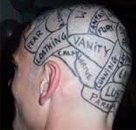Monday, 15 February 2016
Neural Reuse as a Way of Moving Beyond Phrenology

Michael Anderson’s book After Phrenology: Neural Reuse and the Interactive Brain, published in December 2014, offers a relatively new way of looking at the human brain. Phrenology, referred to in the the book’s title, was a pseudo-discipline developed by Franz Joseph Gall in the early 19th century. It postulated that the brain was composed of various modules corresponding to various functions or behaviours observable in human beings. It also postulated that the bumps in a person’s skull corresponded to the personality traits that were more or less developed in that individual, such as mirthfulness, benevolence, ambitiousness, or cautiousness.
This association of such categories with specific brain structures makes us smile today, but we should remember that for more general functions, such as language, the essence of the phrenological approach is still with us now. But now, instead of associating psychological functions with bumps in the skull, we associate them with specific areas of the brain. From Broca and his studies of aphasia in the mid-19th century to Penfield and his direct electrophysiological stimulation of various parts of the cerebral cortex in the mid-20th century, neuroscientists have demonstrated many times that the various regions of the brain are not all the same. That’s without even mentioning all the specific dissociations revealed by neuropsychology and familiar to the general public thanks to books by Oliver Sacks and other authors, or all the functional brain images showing that different tasks activate different parts of the brain.
But as these images show, even the simplest task usually activates in parallel several different parts of the vast network that constitutes the human brain. This fact casts serious doubts on this modular conception of the brain. Although there are not many people nowadays who would defend the most simplistic version of this approach (one region = one function), neuropsychology still operates on the assumption that damage to a specific part of the brain leads to an equally specific psychological deficit. A certain evolutionary approach to brain function, which promotes the idea of “massive modularity” of our brain functions (which may have provided a basis for natural selection), still follows this same pattern.
In his book, Anderson offers an alternative approach based on what he calls “neural reuse”, supported by data demonstrating the dynamic nature of brain activity and of the major neuromodulation of these circuits by molecules that can reconfigure them at any time, as well as an embodied view of cognition that emphasizes the role of the body and the environment.
According to the concept of neural reuse, various parts of the brain may have particular ways of functioning that evolved a fairly long time ago (in the perception/action loop, for example), but as selective pressures have called on the brain to perform more elaborate, abstract, or complex functions, these various areas have been recycled and begun to work together so that all of them have contributed to the development of these functions.
Anderson cites numerous studies supporting the idea of neural reuse. For example, some studies show how certain brain structures associated with motor control, which involves the application of sequential rules, may have been reused to apply the sequential rules of grammar that make language possible. Other studies show that human brain structures associated with spatial navigation, such as the hippocampus, appear to have been reused to support episodic and semantic memory. And certain sensory areas of the brain (such as the left ventral occipito-temporal described by Dehaene et al.) appear to have been reused for more recent faculties such as reading.
I don’t have space to discuss here the many ways in which Anderson shows how this concept of neural reuse can encompass other promising approaches often associated with the theory of embodied cognition. But some good examples are the approach that assigns a central role to metaphor in our cognitive processes and the approaches that attempt to anchor our high-level symbolic representations in lower-level perceptual structures.
In Anderson’s view, if we truly want to achieve a “post-phrenological” science of the brain, then we must accept that the functions that it performs depend far more on the interaction among the various parts of its network than among these parts seen as centres whose activation generates the function. In other words, we need to get away from the modularity that still profoundly marks the cognitive sciences. Instead, we must draw the full implications of the data showing just how much the brain is above all a dynamic, ever-changing network in which many areas are constantly working together, and in which each probably contributes some basic kind of know-how whose re-use in combination with that of the other areas successfully generates new, complex functions far more economically than if the brain had to rebuild each of them again from scratch.
![]() After Phrenology: Neural Reuse and the Interactive Brain
After Phrenology: Neural Reuse and the Interactive Brain
![]() Précis of After Phrenology: Neural Reuse and the Interactive Brain
Précis of After Phrenology: Neural Reuse and the Interactive Brain
Evolution and the Brain | Comments Closed








